So we finally made the decision to go to the Galapagos Islands, having found a great last minute deal giving us a 40% discount on a 8 day cruise aboard a first-class yacht
called the Cachalote, meaning Sperm Whale in Spanish. It can hold up to 16 passengers and when the group all met up at the airport it was a nice mix of Brits, Canadians and Aussies with the odd Irish, American and one lone
Frenchman thrown into the bunch.
Arriving at the airport we were met by our guide, Monica, who, with over 16 years experience, turned out to be a fountain of Galapagos knowledge, there was nothing she didn’t
know about the islands and it’s inhabitants. She took us over to our yacht and we met the crew and had our first panga ride (zodiac or dingy to most people), boarded the boat and took in the luxury settings we had signed
up for, wow, we really aren’t backpackers now!

After lunch we set sail towards our first landing, spotting jumping manta rays, turtles and having the Magnificent Frigate bird sail along right next to us.
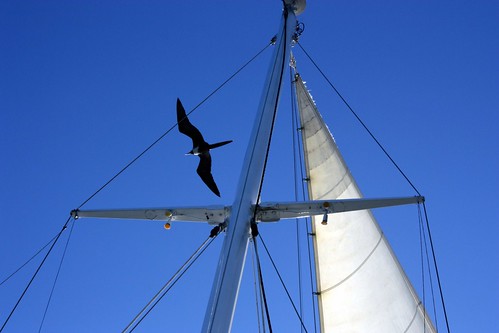
South Plaza
If you were wondering how much wildlife you actually get to see in the Galapagos, you can rest assured that on our first landing we were literally stepping over sea lions,
land and marine iguanas, sally lightfoot crabs and lava lizards, just to get ashore. They are scattered all over the walkways and can go wherever they like, not to mention the gaggle of birds that live along the cliff top.
This area gave us our first insight into nearly all the wildlife we would encounter throughout the Galapagos along with scenic views and landscape.
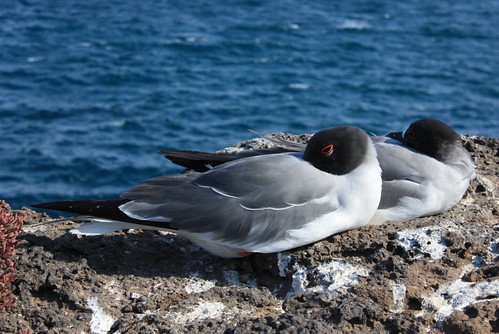
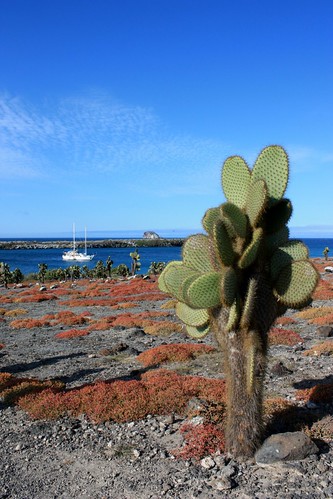 After leaving South Plaza we had a 4 hour sail to Puerto Ayora bay where we would anchor for the night. However, after a few hands of cards with our shipmates and the rocking
of the boat, we both had to head down to our cabin to enjoy the delights of sea sickness. After we anchored we felt much better and could enjoy our cocktail welcome dinner with the Captain. We could get used to this standard
of travel, apart from the vomit!
After leaving South Plaza we had a 4 hour sail to Puerto Ayora bay where we would anchor for the night. However, after a few hands of cards with our shipmates and the rocking
of the boat, we both had to head down to our cabin to enjoy the delights of sea sickness. After we anchored we felt much better and could enjoy our cocktail welcome dinner with the Captain. We could get used to this standard
of travel, apart from the vomit!
Santa Cruz
After a hearty breakfast (the chef really did feed us well throughout the whole cruise, think Christmas Day standards), we visited the Charles Darwin Research Centre, which
is home to Lonesome George, the last surviving tortoise of his species from Pinta Island. Each island has it’s own species of tortoise and even though they have tried to get George to mate with the two ladies he shares
his pen with, he has never been able to reproduce, so his particular species is in danger of becoming extinct. Well at 100 years old, he still has another 100 years to go, so he will probably out live us all.
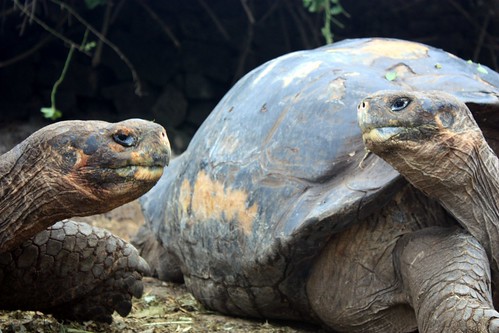
It is somewhat strange to name the main research centre after someone who broke nearly every rule the Galapagos Islands have today, like eating and riding giant tortoises!
However, Darwin was and probably is still the Islands most famous visitor and he himself called the Islands the origin of the Origin of Species. Indeed all of the animals here have adapted and evolved to enable themselves
to survive on these Islands alone, which means that everything is endemic and called the Galapagos something or other, which our guide Monica was very quick to pick us up on if we forgot to use the word Galapagos when naming
anything. For example, the Galapagos Yellow Warbler (Rav's Fav!)
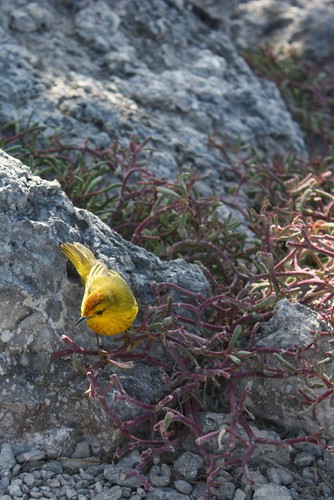
We had a chance to wander around the town of Puerto Ayora and visit the fish market, where a scoop of pelicans along with a curious sea lion await any left overs from the fish gutting
tables. You can also find iguanas roaming down the streets and sea lions taking over the promenade benches.
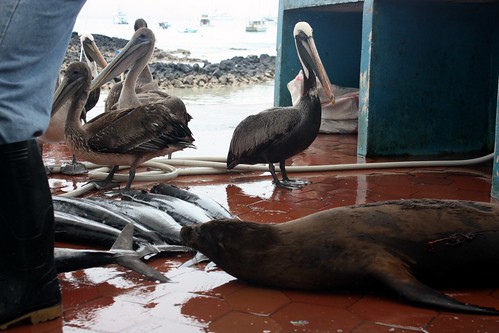
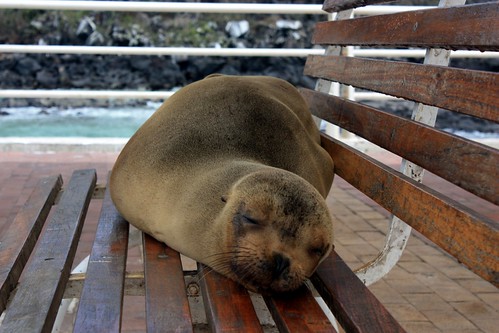
In the Santa Cruz highlands we went Giant Tortoise spotting, but that’s not really too difficult because a) they don’t move very quickly and b) they tend to stay in the
same place most of the year. But we found a few friendly giants who were happy to have us watch them racing around for a few hours.
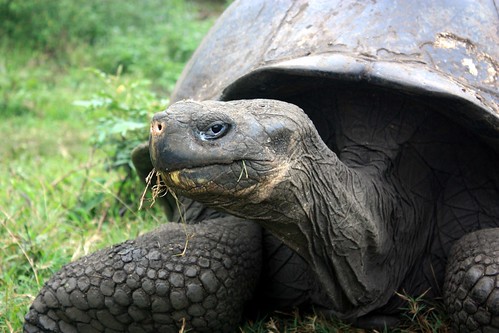
Española
To get to Española we had to sail all night long. We left the bay at 10pm and anchored at 7am. We were dreading the return of seasickness but found that the sound of the engine
and the rock and roll of the waves sent us into a nice deep sleep.
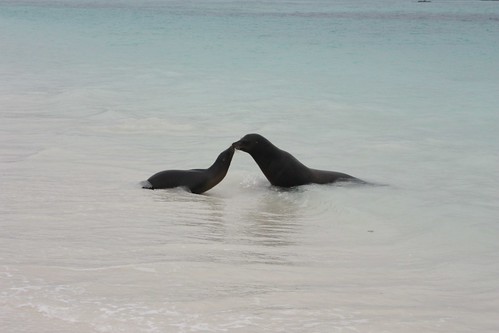
We landed at Gardner Bay shortly after 8am, which is home to a colony of sea lions. We found one little baby sea lion that was only 3 hours old and was making it’s way down
to the sea for it’s first ever swim. Muy bonito!
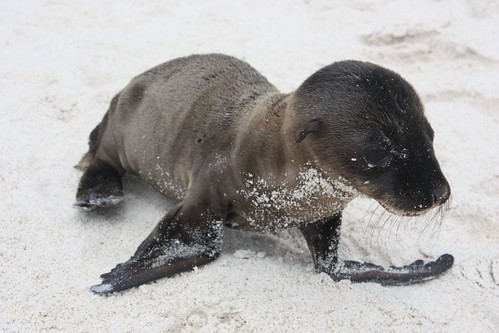
We then had our first snorkelling excursion at Gardner Islet, and even with wetsuits on none of us could stand the freezing water for the whole hour. At this time of year
the Antartic Humboldt current sweeps through the Galapagos, supporting an abundance of marine life and making life uncomfortable for snorkellers. Determined not to let the cold get to us, Ryan and I let the others shiver on
the panga while we stayed as long as we could (we have to get our moneys worth!) and were rewarded when a sea lion pup came to play with us and just seeing his big curious eyes as he darted right at us made us instantly forget
the cold water.
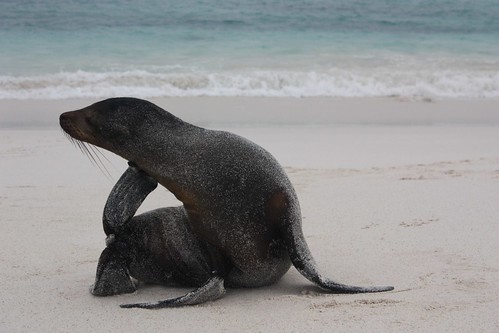
At Suarez Point we were initiated into the Bird Spotters club where a huge variety of birds awaited us, alongside hundreds of Blue Footed Boobies looking after their young
and doing their sky pointing mating rituals, and they really do have blue feet!
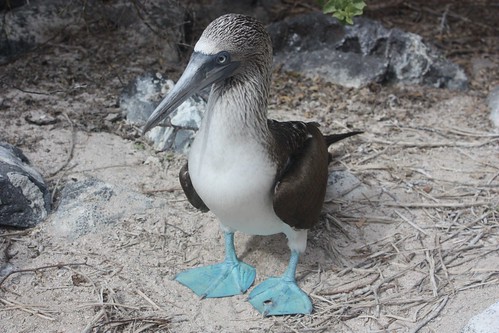
This area is also home to the Waved Albatross, the only place to find them in the Galapagos Islands, which were an amazing sight to see when they launched themselves off the
cliff to go fishing, leaving their cute chicks behind for prying photographers.

Floreana
After another night sailing we arrived at Cormorant Point on Floreana, where we could get up close to the frequently encountered Sally Lightfoot Crab, whose bright red and
blue colours always add a dash of brilliance to every volcanic landscape.
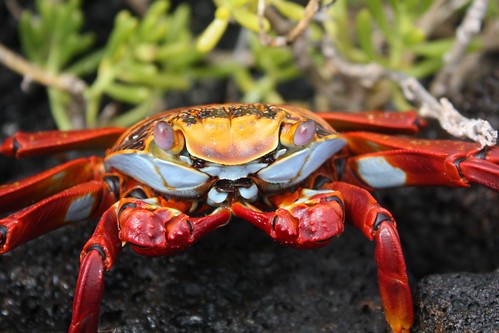
We then sailed around to the Post Office Bay where there is an old mariners post office barrel that is still in use today. The idea is to add any post you need sending around
the world, and if a sailor or boat is heading in the same direction, they will pick it up and deliver it for free. Nowadays, the majority of mail is from tourists sending postcards to relatives, hoping another tourist is from
the same town. Even though we didn’t find any addresses we knew, one of our team from London found a card marked for only two streets from where she lives, so can deliver it by hand. We left a couple of postcards there for
our nephews and nieces, so we can see how long it takes for them to be posted, if ever.

We also had a couple of snorkelling expeditions around the coastline and came face to face with Pacific Green Turtles, who happily munched on algae and glided along gracefully
while we swam along with them. Wow! This became a daily occurrence for us, braving the cold waters once or twice a day and every time finding turtles, sea lions, rays and even a sea horse amongst the schools of coral fish.
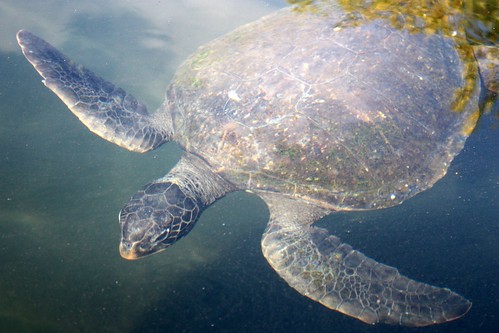
We then had to leave earlier than usual to make our way over to the western islands but this gave us plenty of ocean watching time and we saw some whales too, including the
spouts of some Blue Whales. Unfortunately, the sea was pretty rough and the evening soon saw the numbers dwindle. At dinner when Richard the waiter brought out the sticky table cloths we knew we were in trouble. With four people
missing from dinner (including poor Ryan) the rest of us could hardly finish a plate of food and no one returned for seconds. Soon the dining room was empty as we all retired early to bed. I’m sure I was on the verge
of falling out of bed a few times.
Isabela
At Punta Moreno bay we had to trek over Panhoe-hoe lava fields that are only two hundred years old and the lagoons hidden amongst the rippling black lava threw a few surprises
at us including a trio of White Tip Reef Sharks and Flamingos.


Elizabeth Bay is surrounded by red mangroves so we spent the afternoon in the panga boats sailing around and met our first Galapagos Penguins, Flightless Cormorants and Galapagos
Tree Sea Lions, which are really just regular sea lions which like to climb up into the mangrove branches for a rest!
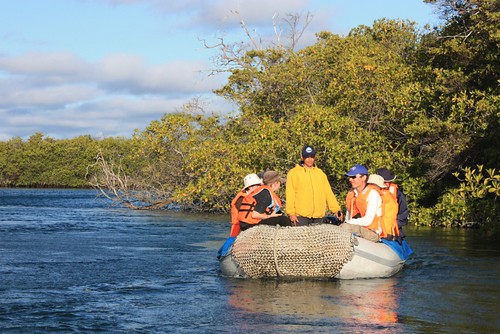
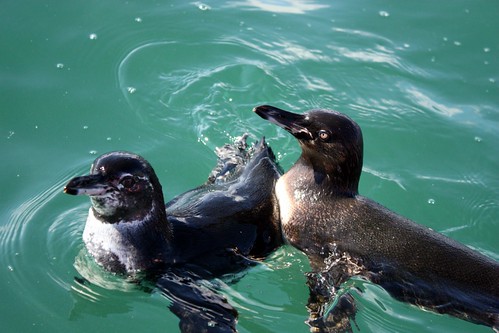
At Urbina Bay we found more wild giant tortoises and the land iguanas that live on every island plus a few lava lizards on the lava of all places.
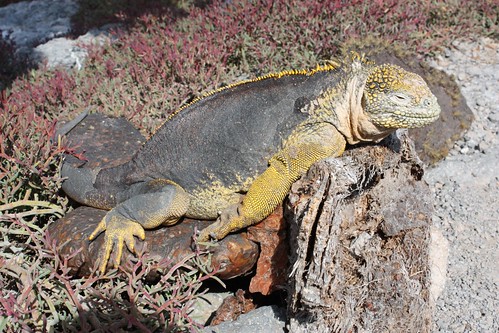

Fernandina
The youngest of all the islands at only 6000 years old, which sounds old until you compare it to Española that is nearer 5 million years old. The landscape is just a hardened
flow of lava that came from the volcano towering overhead. The Galapagos sits above the Pacific Ring of Fire and a hot spot in the Earth’s crust meaning all the islands were formed from volcanic eruptions and its an ongoing
process with new eruptions happening constantly in the area. To make matters more interesting the islands are moving east towards the mainland, about 1 meter each year, to the extent that Española is gradually disappearing
under the sea.
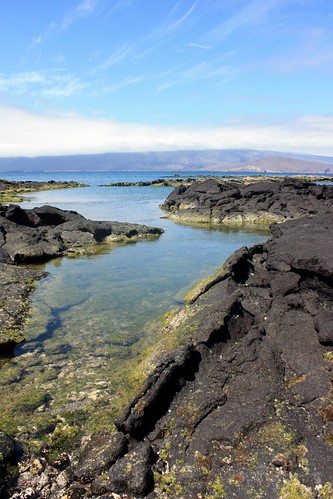
At Espinoza Point we were able to catch up with our friends the Marine Iguanas for about the sixth time, but this time we had the joy of watching them swimming into shore
after grazing on algae under the sea. This exhausts them so much that they spend the rest of the day lazing around all over one another, snorting out the salt they can’t digest, pleasant creatures!
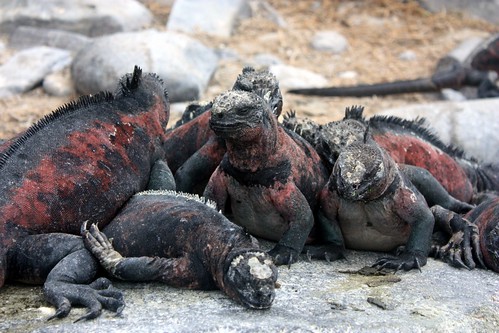
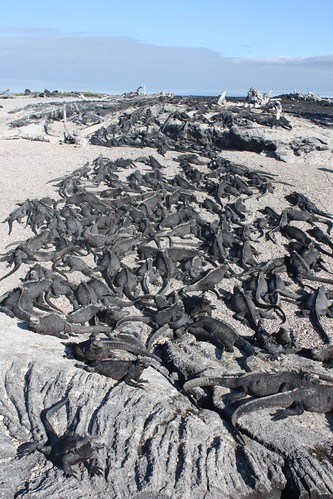
Our afternoon sail gave us more ocean watching time and when we caught sight of several splashes on the horizon the Captain sailed us nearer. It turned out to be a pod of
over 600 common Dolphins fishing for their dinner. As far as the eye could see and riding the crest of every wave were dolphins jumping and flipping about, a spectacular sight I never imagined witnessing.
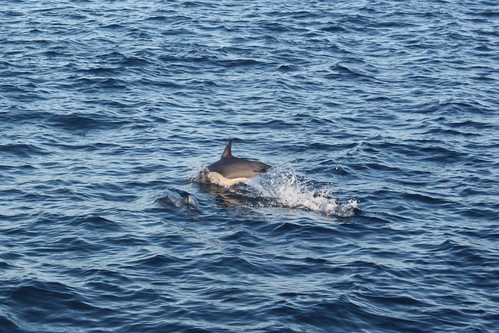
Later on that night just as the sun was setting we crossed the Equator and heard the official beep as the radar read 0 degrees on every level, marking our return to the northern
hemisphere, but only for about 3 hours while we sailed around the top of Isabela to get to our next island, which was back in the southern hemisphere.

Santiago
Arriving at Egas Port we were introduced to the Galapagos Fur Seal, which is actually a type of sea lion wrongly named, but equally cute in appearance. Even though it was
a very cold and blustery day the hardcore snorkellers, Myself, Ryan and French Freddie, decided to give it a go and were rewarded with some of the best underwater views and a playful young sea lion who played with us for ages
swimming right up to our faces and curving over our bodies.
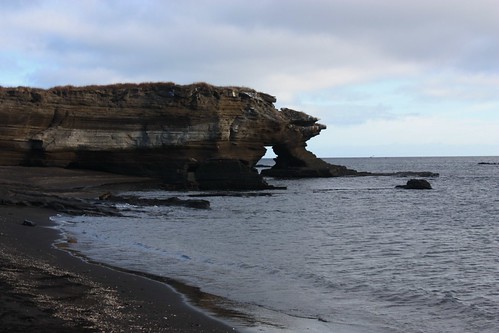
Bartolome
Later in the afternoon we arrived at our last destination and our last chance for snorkelling and this time we were joined by a penguin. Afterwards, we took a short hike up to a view point to get a panoramic view of the islands and Pinnacle Rock.

The evening and cruise was brought to a conclusion with a farewell cocktail dinner presented by the Captain and all the crew, who were all great guys and tolerated our dodgy
Spanish practice on them.

What a fantastic time we had. It is an expensive trip to take, especially for backpackers, but it’s worth every penny. A unique wildlife experience never to be forgotten.
Jo y Ryan
Photos: http://www.flickr.com/photos/dojo77/